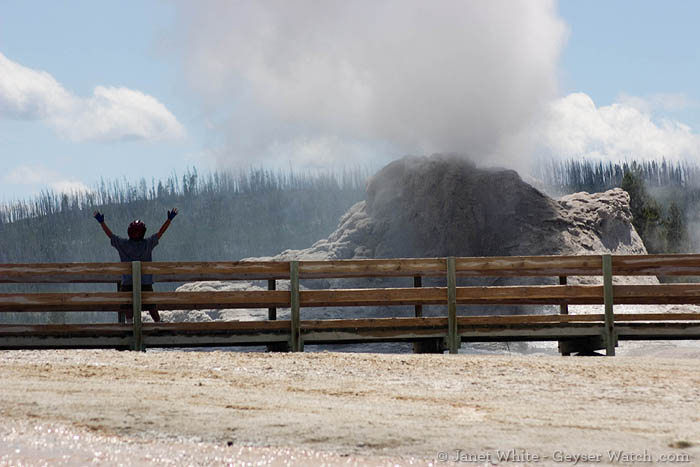
Geysers in Yellowstone National Park are great way to introduce kids to the science behind thermal features. (Janet White/Geyser Watch - click to enlarge)
By Janet White
Young children often have short attention spans while older kids are sometimes more interested in texting than wildlife watching. Which is why Old Faithful geyser is among the most popular family attractions in Yellowstone National Park. It provides a predictable and guaranteed natural wonder that performs on schedule. But that also makes it one of the most crowded places in the park.
But there are other geysers in Yellowstone that are far less crowded, just as fascinating and almost as predictable in their eruptions schedules. Geysers can be a great way to introduce kids to the science behind their eruptions and instill a lifelong love of nature. So to help you (and your kids) see geysers erupt without the crowds or the waiting, it helps to know which ones erupt regularly and often. A day of watching water go ‘the other way’ can be great fun. And for some kids, it may capture them while they’re young and develop into something more as they grow.
So if you want to ditch the crowds at Old Faithful, here are some photos and recommendations about a few favorite, predictable geysers you may want to check out with the kids—or on your own—the next time you’re in Yellowstone.
On Geyser Hill:
Geyser Hill is one of the most amazing patches of thermal activity in the world. Located along the boardwalks leading from Old Faithful, there are dozens of geysers and hot springs in this small area, including some of the largest geysers in the world. Wandering among the thermal features on Geyser Hill is a great way to spend time in Yellowstone before or after Old Faithful erupts, or a wonderful spot to learn more about geysers if you’ve already seen Old Faithful a few times.
On average, most people take 30 minutes to an hour to make the Geyser Hill loop and return to the benches by Old Faithful. Of course, that depends on how much time you spend walking, watching and waiting for a particular geyser to erupt. Since Old Faithful erupts about every 90 minutes, if you’ve just missed Old Faithful, this can be a great loop walk to try. Old Faithful is visible from much of Geyser Hill, so depending on the timing, you may also get a chance to witness it from a different vantage point.
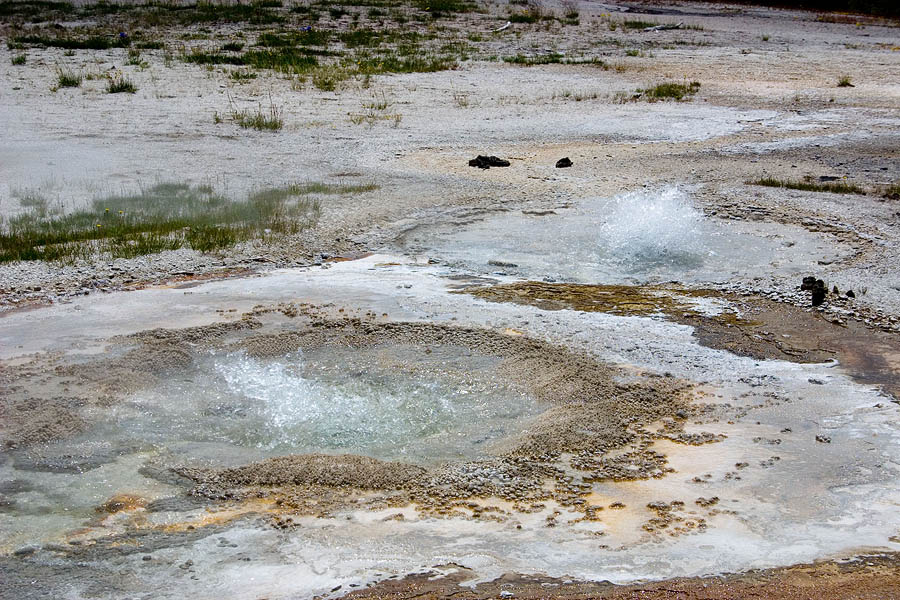
Anemone Geyser on Geyser Hill. (Janet White/Geyser Watch - click to enlarge)
Anemone Geyser:
Anemone Geyser shows the cycle most geysers follow of filling with water, starting to erupt with splashing and then the water drains back into the crater (with a wonderful gurgling sound). You can typically catch a full cycle from Anemone Geyser in about 15 minutes. Anemone has two erupting vents that act a bit like siblings. You have Big Anemone closest to the boardwalk and Little Anemone farther away. Much of the time, they do a good job of taking turns—first one, then the other. But sometimes they play together. At other times, Little Anemone takes extra long turns, only letting Big Anemone play for a very short time. By watching the full cycle, you may get an idea of how these two are acting the day you see them.
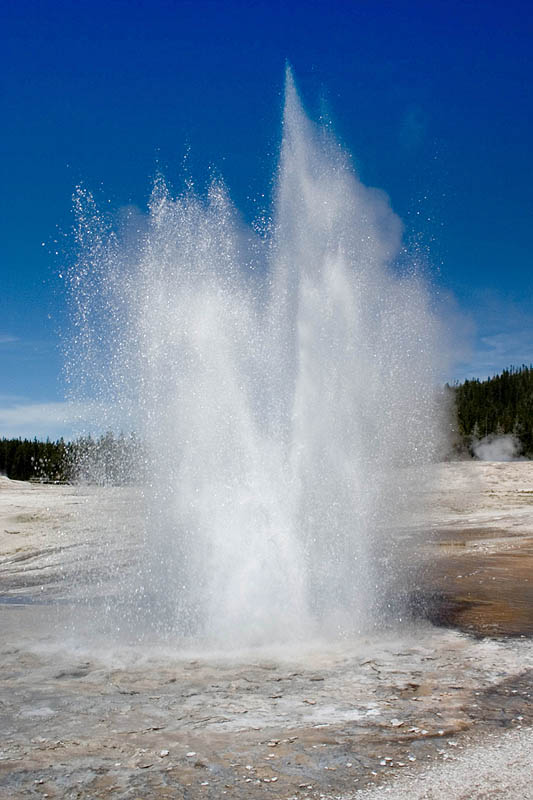
Plume Geyser on Geyser Hill. (Janet White/Geyser Watch - click to enlarge)
Plume Geyser:
Plume Geyser is often quite regular and predictable in its eruption cycles, but it also can take naps and get out of sorts without following regular eruption times. It’s also a great place to wait to watch Old Faithful. You can somewhat set your kids up for the excitement of this one by finding out when Plume’s last eruption time and learning how long it has been between recent eruptions. That way, it’s possible to time your arrival at Plume within 10 minutes or so of its likely eruption time. When not erupting, Plume is easy to walk past, as the crater isn’t very eye-catching. Plume’s eruptions come in multiple bursts, with slight pauses between them, which is a great thing to just let kids discover.
In Black Sand Basin:
Named for the black obsidian sand and gravel scattered throughout the area, Black Sand Basin is less than a mile from Old Faithful. This small geyser basin is an ideal stop for families with small kids looking to take a shorter walk through a beautiful geyser basin. Throughout much of the summer, rangers offer interpretive tours of Black Sand Basin. Check for times on the park website or at any visitor center.
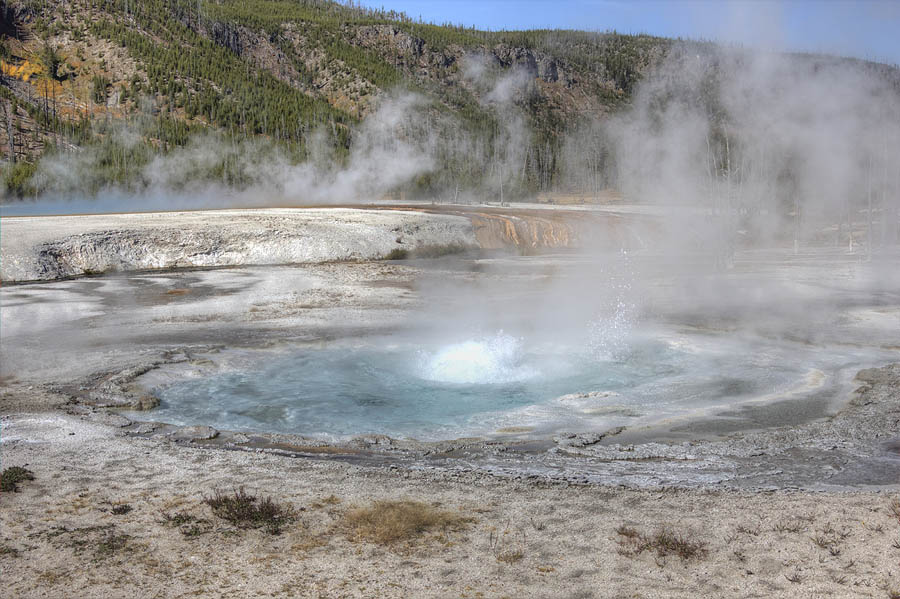
Spouter Geyser in Black Sand Basin. (Janet White/Geyser Watch - click to enlarge)
Spouter Geyser:
While Spouter geyser does pause, when it erupts, it does so with gusto and for a long time. Also, connected to it is “The Grumbler” – a rather large hole right next to the boardwalk that kids of all ages find enchanting.
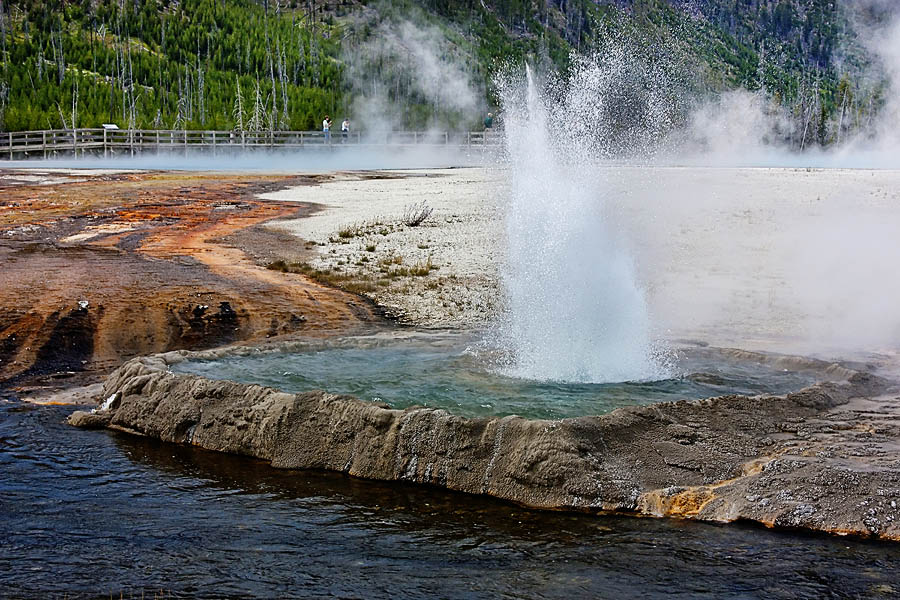
Cliff Geyser in Black Sand Basin. (Janet White/Geyser Watch - click to enlarge)
Cliff Geyser:
Cliff Geyser is visible from the Black Sand Basin parking lot, lying across from Iron Spring Creek. Cliff Geyser erupts for many minutes, starting from an empty crater. As the eruption progresses, the crater fills and the bursts gain height and strength until the water level reaches overflow when the eruptions quit and the water drains. With a short pause, the cycle begins again.
In Biscuit Basin:
Yellowstone Park is in a state of constant change, with earth and water moving and shaping the landscape like few other places in the world. Biscuit Basin is a great example of those changes. Sapphire Pool, a hot spring in Biscuit Basin, was notable for its biscuit-shaped mineral deposits, lending its name to the surrounding area. But the Hebgen Lake earthquake in 1959 dramatically changed how Sapphire Pool behaved. Its clear water became cloudy and roiled. Within days, it began producing powerful geyser eruptions, some as tall as Old Faithful, blasting away the “biscuits” it once held and changing the crater’s shape from nearly round to the oblong shape we see today. Sapphire’s water remained cloudy for a dozen years later, offering kids a great example of how geological forces act over scales measured in days, weeks, years and much longer.
Jewel Geyser:
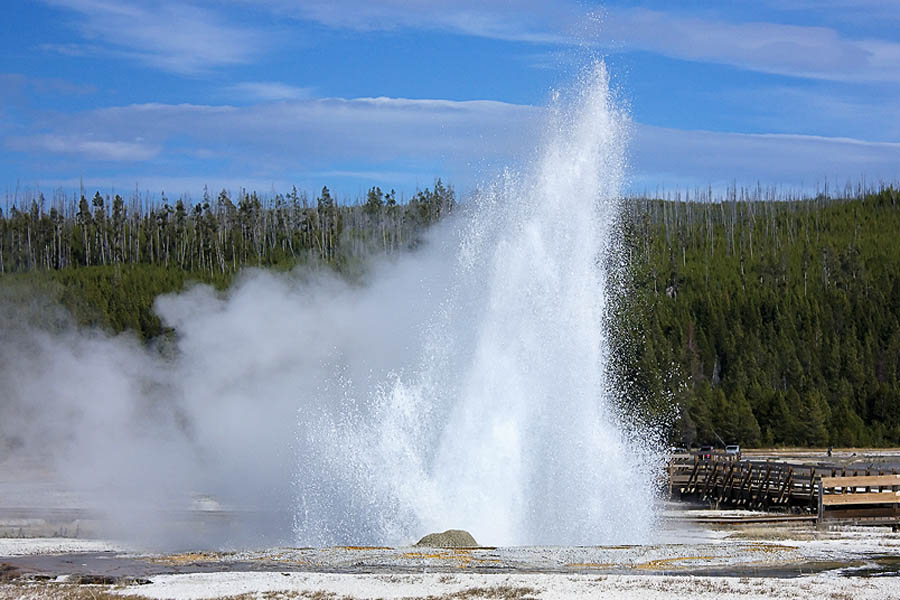
Jewel Geyser in Biscuit Basin. (Janet White/Geyser Watch - click to enlarge)
If you (or your kids) are anxious to see a geyser erupt within about 10 minutes, Jewel Geyser is a good bet. It puts on a wonderful show about every 7-8 minutes, often letting off a tall and impressive blast followed by a few more bursts, which can be counted for kids learning numbers and counting. For a more complex lesson, the number of bursts relates to how long it will be until the next eruption. Jewel received it’s name for the jewel-like beads of rock around the crater.
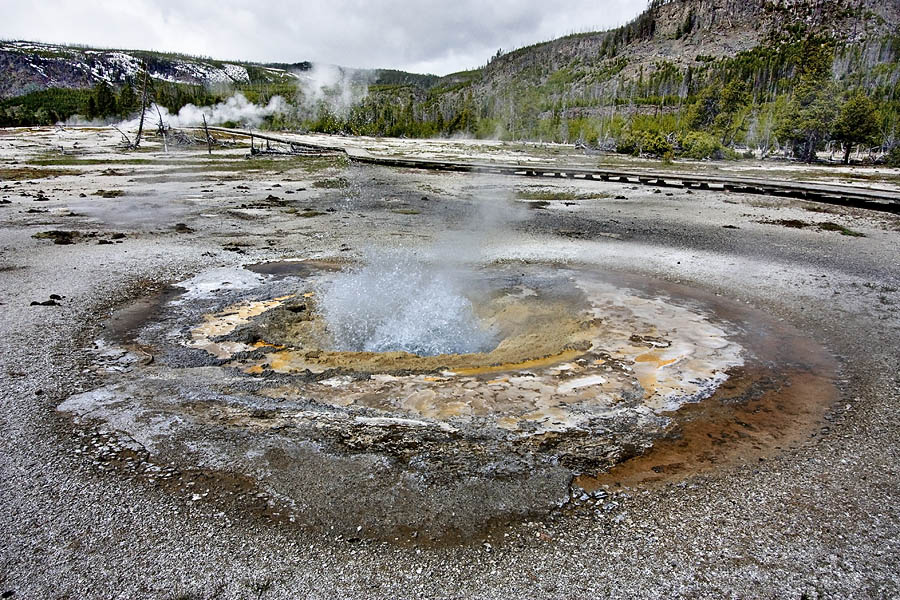
East Mustard Spring in Biscuit Basin. (Janet White/Geyser Watch - click to enlarge)
East Mustard Spring: As you walk the boardwalk around Biscuit Basin, you’ll notice two similar holes, East and West Mustard Springs. Seismic activity through the years has altered their behavior, and West Mustard Spring is typically a dry (former) hot spring. East Mustard Spring is a geyser and can typically erupt about every five minutes, although to modest heights of about five feet or less. This geyser again shows the cycle of geysers without a long wait.
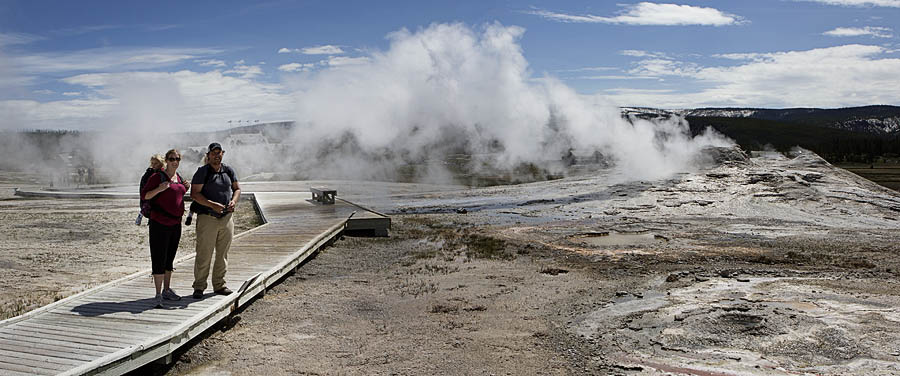
Bethany and Jon Fuqua of Bozeman, Mont. enjoy sharing the fun of the geysers with their 2-year old twin daughters, Sage and Raina. (Janet White/Geyser Watch - click to enlarge)
You never know what experiences will resonate deeply within a child’s heart. But giving them the opportunity to experience the wonders of the geysers and other thermal features in Yellowstone Park may very well be a lifelong gift that grows into a love of science and nature or something more.
Show them those wonders, and see if a spark ignites in them.
Janet White is the creator of Geyser Watch.
